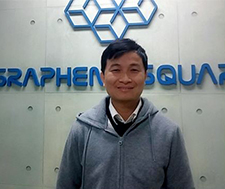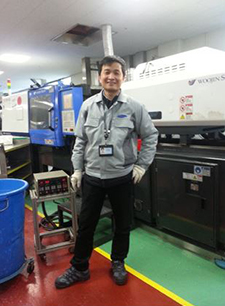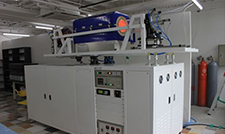Leaving Samsung SDI to achieve the dream of commercializing graphene at Graphene Square.

"Graphene" is the core issue for the next generation IT technology.
Dr. Truong Quang Trung has joined Graphene Square Inc. since April 2015, as a senior research member in the R & D department. Before coming to Korea in 2005, he earned his B.S. degree in Chemistry from Vietnam National University at Hanoi. He continued to earn his masters and doctoral degree in Chemical Engineering at Chonbuk National University in 2012. He had researched and studied about Graphene nano-composite as part of his PhD degree thesis and became further interested in Graphene during that time. After graduating in 2012, he started his career at Samsung SDI for two years focusing on next generation IT technology. In Samsung SDI, he researched polymer compounding with emphasis in optimization of plastics composition to achieve target properties for electronic connector application such LED lamp cover, USB connector.
He stated that the core material leading next generation IT technology is “Graphene,†so his interests are to continue research in graphene related applications, which is the reason for joining Graphene Square, recognized for original technology to synthesize Graphene using CVD method.
*CVD(Chemical Vapor Deposition): the wafer (substrate) is exposed to one or more volatile precursors, which react and/or decompose on the substrate surface to produce the desired deposit.
Graphene from CVD method is far ahead of exfoliation method.
He pointed out that CVD Graphene is more interesting because it can produce large area Graphene and control the number of Graphene layers. He further stated advantages of CVD method is synthesis resulting in less contamination and impurity vs. Graphene derived from Graphite Oxide or from Graphite which in comparison are highly contaminated with impurities.

His current study is focusing in large area Graphene on flexible substrates and working to improve the Graphene manufacturing infra-structure like roll laminator or etching, transfer method with Dr. Kim Wan Soo who is part of National Leading Future Technology project. In order to apply large area Graphene, the most important thing is quality “transfer.†He explained that we have to optimize the process and transfer method so that the damage during the transfer process could be minimized.
An area of consideration, is in the application on lens, where the substrate surface may be curved, so Dr. Trung will continue to study and develop the know how to transfer on such substrate.
Solutions for the commercialization of graphene
He also acknowledged the challenges in commercialization of Graphene. He emphasized priority in research to over coming such challenges.
“It’s difficult to make a large area crystal size graphene. When we synthesize large area graphene on copper foil, it is due to the polycrystalline nature of Cu foil with grain boundaries, graphene growths on different crystal surface with different orientation, therefore, it is not possible to enlarge graphene crystals. And this can strongly effect the electrical conductivity of graphene. To obtain high conductivity, we need to lower the sheet resistance and there are two methods.
One is to improve the quality during synthesis and transfer process [especially, in R2R technology for continuous production].
Second is by doping graphene. Doping means injecting or withdrawing electrons from graphene and the materials used to dope are called dopant. Professor Byung Hee Hong and ?Founder of Graphene Square is a pioneer in the doping methods with patents.
Finally, there is the issue of being cost competitive when producing graphene in comparison to other materials. Currently, graphene is relative expensive because the production technology and yield is limited. It also should be competitive to silver nanowire and CNT. For instance, we need a method to produce good quality, cost competitive graphene to replace ITO used for transparent electrode.â€
*R2R (Roll to Roll) : the process of creating electronic devices on a roll of flexible plastic or metal foil

Graphene Square's No. 1 vision is to grow commercial scale Graphene by CVD method.
Dr. Trung's outlook for the Graphene industry is optimistic in that we can produce large area Graphene using roll to roll and CVD method. He stated that Graphene Square has contributed much to the technology to produce large-area Graphene using a CVD method. He expressed his ambitions to produce differentiated, high-quality Graphene using the exceptional equipment and technical know-how at Graphene Square.



